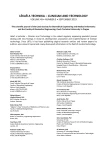APPLICATION OF THE ARTEC EVA SCANNER FOR ORTHOTICS IN PRACTICE
Autoři:
Viktória Krajňáková 1; Monika Michalíková 1; Radovan Hudák 1; Jozef Živčák 1; Miroslava Barcalová 2
Působiště autorů:
Department of Biomedical Engineering and Measurement, Faculty of Mechanical Engineering, Technical University of Košice, Košice, Slovakia
1; Department of Physical Education, Technical University of Košice, Košice, Slovakia
2
Vyšlo v časopise:
Lékař a technika - Clinician and Technology No. 3, 2019, 49, 92-96
Kategorie:
Original research
Souhrn
This article deals with methodology and possibilities of using the Artec Eva scanner (Artec 3D, Luxembourg) in the field of prosthetics and orthotics with a focus on the part of face and neck. The methodology has been divided into 5 basic parts—environment preparation, scanner, subjects, scanning, and 3D modelling. The practical part includes 3D images of selected subjects representing a sample covering various types, especially in terms of the hair, beard, and eye area. Scanner outputs can be used in medicine for the manufacture of prostheses and dental implants and in the design of remodeling and other orthoses on the head.
Klíčová slova:
3D scanner – scanning – Artec Eva
Zdroje
- Lovato C, Castellani U, Zancanaro C, & Giachetti A. 2014. Automatic labelling of anatomical landmarks on 3D body scans. Graphical Models [internet]. 2014. 76(6), 648–657. DOI: 10.1016/j.gmod.2014.07.001
- Freedee. [internet] 2017 [cited 2017April 17]. Available from: http://www.freedee.hu/en/products/3d-scanners/artec-eva - specifications/
- Pandey G, Mcbride J, Savarese S, & Eustice R. Extrinsic calibration of a 3D laser scanner and an omnidirectional camera. IFAC Proceedings Volumes [internet]. 2017 [cited 2016 April 21]. DOI: 10.3182/20100906-3-IT-2019.00059
- Anwar H. Calibrating projector flexibly for a real-time active 3D scanning system. Optik. [internet] 2018 [cited 2018 Jan 5]. 158,1088–1094. DOI: 10.1016/j.ijleo.2018.01.005
- Dúbravčík M. Prostriedky digitalizácie: Technická univerzita v Košiciach [internet] 2005 [cited 2018 April 21]. Availiable from: http://www.sjf.tuke.sk/transferinovacii/pages/archiv/transfer/8 - 2005/pdf/52-54.pdf
- Herbort S, Gerken B, Schugk D, Wöhler C. 2013. 3D range scan enhancement using image-based methods. ISPRS Journal of Photogrammetry and Remote Sensing, [internet] 2017 [cited 2017 Aug. 7]. 84, 69–84. DOI: 10.1016/j.isprsjprs.2013.07.004
- Čelko J, Kováč M, Kotek P. Analysis of the Pavement Surface Texture by 3D Scanner. Transportation Research Procedia, 14, [internet] 2016. [cited 2017 Aug. 7]. 2994–3003. DOI: 10.1016/j.trpro.2016.05.434
- Rusinkiewicz S, Hall-Holt O, Levoy M. Real-time 3D model acquisition. ACM Transactions on Graphics, 21, [internet] 2002. [cited 2017 April 7] 438–446. DOI: 10.1145/566654.566600
- Modabber A, Peters F, Kniha K, Goloborodko E, Ghassemi A, Lethaus B, Möhlhenrich SC. Evaluation of the accuracy of a mobile and a stationary system for three-dimensional facial scanning. Journal of Cranio-Maxillofacial Surgery, [internet] 2016. [cited 2017 April 7] 44(10), 1719–1724. DOI: 10.1016/j.jcms.2016.08.008
- Schweitzer W, Röhrich E, Schaepman M, Thali MJ, Ebert L. Aspects of 3D surface scanner performance for post-mortem skin documentation in forensic medicine using rigid benchmark objects. Journal of Forensic. 2013.
- Shinomiya A, Shindo A, Kawanishi M, Miyake K, Nakamura T, Matsubara S, Tamiya T. Usefulness of the 3D virtual visualization surgical planning simulation and 3D model for endoscopic endonasal transsphenoidal surgery of pituitary adenoma: Technical report and review of literature. Interdisciplinary Neurosurgery: Advanced Techniques and Case Management, [internet] 2018. [cited 2017 November 13], 13–19. DOI: 10.1016/j.inat.2018.02.002
- Wibirama S, Nugroho HA, Hamamoto K. 2017. Evaluating 3D gaze tracking in virtual space: A computer graphics approach. Entertainment Computing, [internet] 2018. [cited 2017 November 13] 21, 11–17. DOI: 10.1016/j.entcom.2017.04.003
- Lee W, Lee B, Yang X, Jung H, Bok I, Kim C, You H. 2018. A 3D anthropometric sizing analysis system based on North American CAESAR 3D scan data for design of head wearable products. Computers and Industrial Engineering 117, [internet] [cited May 2017] 121–130. DOI: 10.1016/j.cie.2018.01.023
Štítky
BiomedicínaČlánek vyšel v časopise
Lékař a technika

2019 Číslo 3
Nejčtenější v tomto čísle
- THE TIME DELAY OF AIR/OXYGEN MIXTURE DELIVERY AFTER THE CHANGE OF SET FIO2: AN IMPROVEMENT OF A NEONATAL MATHEMATICAL MODEL
- GOLF SWING VARIABILITY IN ELITE FEMALE JUNIOR GOLFERS
- APPLICATION OF THE ARTEC EVA SCANNER FOR ORTHOTICS IN PRACTICE
- THE FRACTAL DIMENSION-BASED DESCRIPTOR OF THE MICROVASCULAR PATTERN ON THE HISTOLOGICAL SECTION

